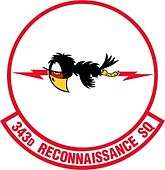343d Reconnaissance Squadron
343d Reconnaissance Squadron
 | |
|---|---|
|
Squadron RC-135 Rivet Joint on deployment | |
| Active | 1943–1946; 1947–1949; 1950-present |
| Country |
|
| Branch |
|
| Role | Reconnaissance and Surveillance |
| Part of | Air Combat Command |
| Garrison/HQ | Offutt Air Force Base |
| Decorations |
Distinguished Unit Citation Air Force Meritorious Unit Award Air Force Outstanding Unit Award |
| Insignia | |
| 343d Reconnaissance Squadron emblem (Approved 25 July 1952)[1] |
 |
| 343d Fighter Squadron World War II emblem[2] |
 |
| World War II fuselage code[2] | CY |
The 343d Reconnaissance Squadron is part of the 55th Wing at Offutt Air Force Base, Nebraska.
History
Word War II
The 343d flew combat missions in the European Theater of Operations from 15 October 1943 to 21 April 1945.
Cold War
It conducted aerial photography from 1947–1949 and global strategic reconnaissance from 1950 to 1979.
Since 1979 the squadron has provided worldwide strategic reconnaissance support, including operations in Grenada in 1983, Libya in 1986, and Southwest Asia from 1990-1991.[1] On 29 July 1953 a squadron RB-50 temporarily attached to the 91st Strategic Reconnaissance Squadron was shot down by Soviet fighters about ninety miles south of Vladivostok. The Soviet Union did not deny the plane's location was over water, but claimed that the bomber had twice flown over Soviet territory and fired on their MiGs, who then returned fire defensively.[3]
Lineage
- Constituted as the 343 Fighter Squadron (Twin Engine) on 21 January 1943
- Activated on 1 February 1943
- Redesignated 343 Fighter Squadron, Twin Engine on 20 August 1943
- Redesignated 343 Fighter Squadron, Single Engine on 5 September 1944
- Inactivated on 20 August 1946
- Redesignated 343 Reconnaissance Squadron, Very Long Range, Mapping on 5 February 1947
- Activated on 24 Feb 1947
- Redesignated 343 Strategic Reconnaissance Squadron, Photo-Mapping on 29 June 1948
- Inactivated on 14 October 1949
- Redesignated 343 Strategic Reconnaissance Squadron, Medium, Electronics on 27 October 1950
- Activated on 1 November 1950
- Redesignated 343 Strategic Reconnaissance Squadron, Medium on 15 July 1954
- Redesignated 343 Strategic Reconnaissance Squadron on 16 August 1966
- Redesignated 343 Reconnaissance Squadron on 1 September 1991[1]
Assignments
- 55th Fighter Group, 1 February 1943 – 20 August 1946
- 55th Reconnaissance Group (later 55 Strategic Reconnaissance Group), 24 February 1947 – 14 October 1949
- Attached to 55th Strategic Reconnaissance Wing, 19 July - 26 October 1948
- 55th Strategic Reconnaissance Group, 1 November 1950
- Attached to 91st Strategic Reconnaissance Wing until 3 January 1951
- Attached to 55th Strategic Reconnaissance Wing after 4 January 1951
- 55th Strategic Reconnaissance Wing, 16 June 1952
- 55th Operations Group, 1 September 1991 – present[1]
Stations
- McChord Field, Washington, 1 February - 22 August 1943
- RAF Nuthampstead (AAF-131),[4] England, 16 September 1943
- RAF Wormingford (AAF-159),[4] England, 16 April 1944
- AAF Station Kaufbeuren, Germany, c. 20 July 1945
- AAF Station Giebelstadt, Germany, 30 April - 20 August 1946
- MacDill Field (later MacDill Air Force Base), Florida, 24 February 1947
- Topeka Air Force Base (later Forbes Air Force Base), Kansas, 30 June 1948 – 14 October 1949
- Barksdale Air Force Base, Louisiana, 1 November 1950
- Ramey Air Force Base, Puerto Rico, 3 January 1951
- Forbes Air Force Base, Kansas, 10 October 1952
- Deployed at Ben Guerir Air Base, French Morocco, 30 May 1955 – 8 August 1955
- Offutt Air Force Base, Nebraska, 16 August 1966 – present[1]
Aircraft
- Lockheed P-38 Lightning (1943–1944)
- North American P-51 Mustang (1944–1946)
- Lockheed P-80 Shooting Star (1946)
- F-2 Expeditor (1947, 1948)
- FB-17 Flying Fortress (1947–1948)
- Boeing F-9 Flying Fortress (1947–1948)
- RB-17 Flying Fortress (1948–1949)
- Boeing RB-29 Superfortress (1948–1949, 1950–1951)
- TB-29 (1949)
- Boeing RB-50 Superfortress (1951–1954)
- Douglas C-47 Skytrain (1953–1954)
- Boeing LB-29 Superfortress (1954)
- Boeing KB-29 Superfortress (1954)
- Boeing RB-47 Stratojet (1954–1967)
- Boeing EB-47 Stratojet (1957–1967)
- Boeing RC-135 (1967–1979)[1]
Operations
References
Notes
Bibliography
![]() This article incorporates public domain material from the Air Force Historical Research Agency website http://www.afhra.af.mil/.
This article incorporates public domain material from the Air Force Historical Research Agency website http://www.afhra.af.mil/.
- Anderson, Capt. Barry (1985). Army Air Forces Stations: A Guide to the Stations Where U.S. Army Air Forces Personnel Served in the United Kingdom During World War II (PDF). Maxwell AFB, AL: Research Division, USAF Historical Research Center. Retrieved July 7, 2012.
- Farquhar, John T. (2015). "Aerial Reconnaissance, the Press, and American Foreign Policy, 1950-1954" (PDF). Air Power History. Air Force Historical Foundation. Vol. 62 (Number 4). Retrieved January 6, 2016. (web access limited to members)
- Maurer, Maurer, ed. (1983) [1961]. Air Force Combat Units of World War II (PDF) (reprint ed.). Washington, DC: Office of Air Force History. ISBN 0-912799-02-1. LCCN 61060979.
- Maurer, Maurer, ed. (1982) [1969]. Combat Squadrons of the Air Force, World War II (PDF) (reprint ed.). Washington, DC: Office of Air Force History. ISBN 0-405-12194-6. LCCN 70605402. OCLC 72556.
- Ravenstein, Charles A. (1984). Air Force Combat Wings, Lineage & Honors Histories 1947-1977 (PDF). Washington, DC: Office of Air Force History. ISBN 0-912799-12-9.

